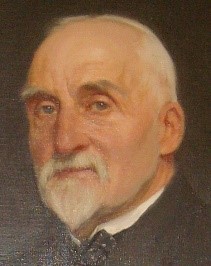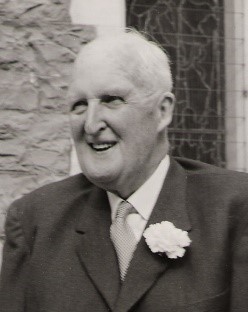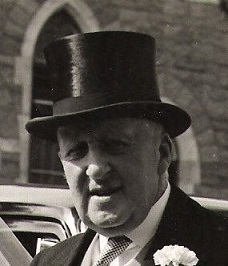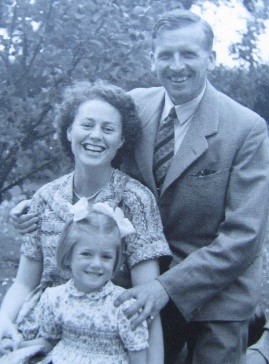|
<< Back to the main Local History page
Speech Written by James Cyril Strangman Hill in 1974
I feel it a great honour to be asked to give a history of Hill & Sons but you must realise that it may contain errors of both omission and commission and I am having to rely entirely on my own memory of facts that were told to me by my father and other people who are now no longer with us.
The site on which our factory now stands was originally used as an iron mill, this fact has been borne out by clinker we found when new foundations were being excavated for building.
The first member of my family in the textile trade was my great-grandfather William Strangman Hill (1802-1877) who ran a woollen mill at Bluebell, Inchicore, where I think the Nugget factory now stands.
Mr Hill, like a lot of people in the middle of the 19th Century, used to travel on horseback and one day he stopped his horse on the Lucan Bridge and looking around him saw a notice that the Iron Mill was for sale.
About that time, about 1860, Mr Hill had two young sons, one of them was my grandfather, James William Hill (1847-1927), whom some of you may remember as he only died in 1927; the other son was named Samuel (1844-1891).

James William Hill
Their father felt that if he could buy this site in Lucan, when they grew up and he got older one of his sons could look after the Bluebell Mill and the other one the Lucan Mill.
So about 1863 a textile mill was started in Lucan and a few years later my grandfather was put in charge of it. He lived in a house called “Greenvale” beside the factory for about 20 years until “Clanaboy” was built about 1885 and in fact Greenvale itself was only demolished about five years ago when our new offices were built.
My great-grandfather died in 1877 two months after my father, the second William Strangman Hill (1876-1968) was born and the two brothers James and Samuel ran Lucan and Bluebell as a combined firm for the next 14 years.

William Strangman Hill Jnr
In 1891 Samuel died at the early age of 47 years from an injury he received in the hunting field, his widow (Sarah “Sissie” Elizabeth Hill nee Russell), who really took no interest in the business decided to go and live in England and took with her young family.
This was a terrible blow for James who also had a young family, the eldest being my father, then aged about 15 years and my grandfather decided that he could not possibly look after both mills satisfactorily and so Bluebell was sold: some of its’ machinery was transferred to Lucan and also staff, the descendants of some of who are happily still with us.
My grandfather’s three eldest sons, my father and his two brothers, Mr Ernest (1882-1923) and Mr Howard Hill (1885-1967), joined the business as they left school and college and they were ably assisted by Mr Sneddon and his son William. “Willie Sneddon”, as he was always affectionately known, will be remembered by many of you as he only retired in 1953 and died in 1955. Mr Sneddon Senior retired in 1934 and left the Managers’ house where he had lived and where my grandfather originally lived and he and his son and daughter went to live in Chapelizod where he
died in 1940.

Howard Hill
The Great War 1914/18 brought a lot of business to the firm who were contractors to the Allied forces and when it was over a serious recession set in and this culminated in the one and only serious strike we have ever had, in 1920, and which lasted about four months. Apart from this one incident, relations between management and staff have always been of the friendliest nature, a fact of which we are all intensely proud.
Mr Ernest Hill died suddenly in 1923 at the early age of 40, a loss from which I do not think my grandfather ever really recovered.
Mr Stringer joined the firm in 1935, the author of this article in 1937 and Mr White in 1938, while in 1941 Mr Kenneth Downey (1920-2010), another grandson of James William Hill came to us: he stayed until 1959 when re resigned and went and settled in Canada.

Ken Downey
September 1939 brought the Second World War with all its’ problems and on this occasion, owing to the Irish neutrality, we were suppliers of Army uniforms to the Irish armed forces. So far as we are aware all the various cloths used were originally designed in Lucan.
The War was only two months old when we suffered a disastrous blow when in November 1939 a fire destroyed our Yarn Store and Wet Finishing Plant. While any fire enables re-building to be done in a more modern way, nevertheless we could ill afford at that time of growing shortages the loss of valuable raw materials and plant.
The end of the War in 1945 brought fresh problems as it was essential to modernise both in buildings and plant. In 1948 we added a further extension to the Weaving Shed and in 1952 completely re-built the Spinning Shed.
In 1957 Mr Dunlop (no relation to Joyce Dunlop below) joined the firm and we know that anybody who knows anything about the firm will realise that he has certainly made his mark during the 17 years he has been with us culminating in his being appointed Managing Director when Mr Stringer retired in 1967.
In 1962 we had our second fire when in January of that year the Carding Room with five sets of machines was completely destroyed. Opportunity was taken during the re-building operations to modernise both the Blending and Carding Departments.
Various further new outbuildings have been erected since that time including modernisation of the Weaving, Winding and Mending Departments and in 1970 the erection of new warehouses and offices.
We are now well in our second century and every month seems to bring new problems, but we must go forward or else we will go back for no business can stand still.
However with the help of our loyal and devoted staff and provided there are no political upheavals or any other events entirely beyond anybody’s control we are confident that the firm may be able to continue to serve the community in the future as it has done in the past.
James “Cyril” Strangman Hill (1912-1999) – Author
Article provided by the Children of Joyce Lilian Dunlop (nee Hill) and Daughter of Cyril Strangman Hill.
Joyce Lilian Hill (1933-2020) who was the Half-Sister of James “Cyril” Strangman Hill (Author).

James “Cyril” Strangman Hill with his wife, Daffodil, and Daughter, Heather
Notes attached to article written by Joyce Dunlop at the beginning of 2020:
This must have been written by Cyril when he had to give a speech to the workers or for a magazine.
My father (William Strangman Hill Jnr) was born at “Greenvale”. My Uncle Howard lived with his unmarried sister, Eileen, in “Clanaboy” when I was growing up. Howard followed the hunt and tried to get me interested!
As a child of six I remember the fire and was frightened to walk past in case the remaining wall fell on me! I remember them making the cloth for Air Lingus staff uniform, they were also famous for blankets. I think they employed between 200 and 300 workers. There were two rows of workers cottages below “Ounavarra” (where I was brought up) and “Clanaboy”.
(JLD)
|

